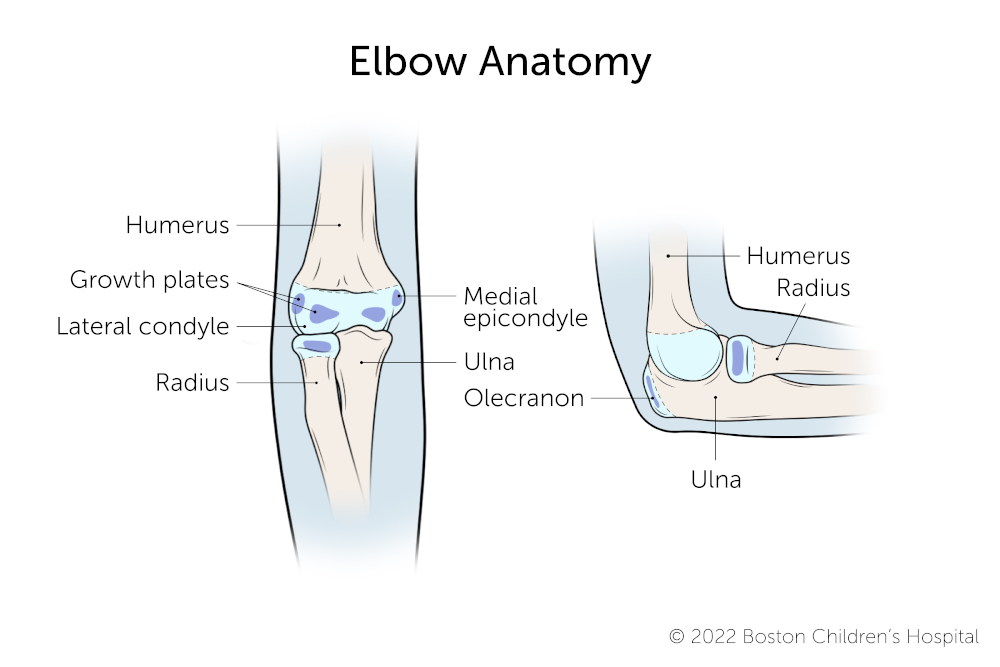Broken Elbow | Symptoms & Causes
What are the signs and symptoms of broken elbows in children?
- pain or swelling in the elbow or forearm
- an obvious deformity in the elbow or forearm
- difficulty moving, flexing, or extending the arm normally
- warmth, bruising, or redness at or near the elbow
What causes broken elbows in children?
A bone breaks when there’s more force applied to the bone than it can withstand. These breaks can occur from falls, trauma, or a direct blow. Most childhood fractures result from mild to moderate (rather than severe) trauma that happens while children are playing or participating in sports, with the rate of fractures peaking in adolescence, especially among boys.
Broken Elbow | Diagnosis & Treatments
How are broken elbows in children diagnosed?
To diagnose broken elbows in children, the doctor will carefully examine the injured area for tenderness, redness, and swelling.
One or more of the following imaging techniques may also be used to get pictures of the broken bone and to check for damage to muscles or blood vessels.
- X-ray: The main tool used for diagnosing a broken bone. This painless test uses small amounts of radiation to produce images of bones onto film. After the doctor puts the pieces of the broken bone in the right position, an x-ray can also help determine whether the bones in the arm are healing in the proper position.
- Magnetic resonance imaging (MRI): Some fractures (such as stress fractures) don't show up on an x-ray until a few weeks after the bone starts hurting. An MRI is a diagnostic procedure that uses a combination of large magnets, radio frequencies, and a computer to produce detailed images of organs and structures within the body. These types of tests are more sensitive than x-rays and can pick up smaller fractures before they get worse.
- Computed tomography scan (CT, CAT scan): A diagnostic imaging procedure that uses a combination of x-rays and computer technology to produce cross-sectional images (often called slices), both horizontally and vertically, of the body.
- Bone scan: A painless imaging method that uses a radioactive substance to evaluate bones and determine the cause of pain or inflammation. Bone scans are also useful for detecting stress fractures and toddler’s fractures, which can be hard to see on x-rays.
How are broken elbows in children treated?
The treatments for broken elbows in children depend on the location and severity of the fracture as well as the child's age and overall health.
In most cases, broken elbows in children are treated with a splint or cast, which immobilizes the injured bone(s) to promote healing and reduce pain and swelling. Splints and casts may also be put on after surgical procedures to ensure that the bone is protected and in the proper alignment as it begins to heal.
Splints are used for minor breaks. Splints support the broken bone on one side and immobilize the injured area to promote bone alignment and healing. Splints are often used in emergency situations to hold a joint in a steady position during transportation to a medical facility.
Casts are stronger than splints and provide more protection to the injured area. They hold a broken bone in place while it heals by immobilizing the area above and below the joint. Casts have two layers: a soft inside layer that rests against the skin and a hard outer layer that prevents the injured bone from moving.
Some common types of casting for broken elbows include:
- Short arm casts extend from the elbow to the hand and are used for forearm or wrist fractures or to hold the arm in place after surgery.
- Long arm casts extend from the upper arm to the hand and are used for upper arm, elbow, or forearm fractures. They are also used to hold the arm in place after surgery.
Other treatments for broken elbows include:
- Surgery: May be needed to put broken bones back into place. A surgeon may insert metal rods or pins located inside the bone (internal fixation) or outside the body (external fixation) to hold bone fragments in place to allow alignment and healing. This is done under general anesthesia.
- Traction: Corrects broken or dislocated bones by using a gentle and steady pulling motion in a specific direction to stretch muscles and tendons around the broken bone. This allows the bone ends to align and heal, and in some cases, it reduces painful muscle spasms.
- Closed reduction: A nonsurgical procedure used to reduce and set the fracture. Using an anesthetic (typically given through an IV in the arm), the doctor realigns the bone fragments from outside the body and holds it in place with a cast or splint.
- Physical therapy: May be needed to strengthen the arm, restore range of motion, and help the arm return to full function after treatment and/or casting.



